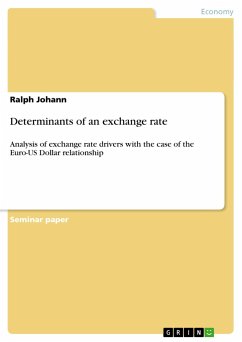Seminar paper from the year 2005 in the subject Business economics - Banking, Stock Exchanges, Insurance, Accounting, grade: 1,3, California State University, Fullerton, course: International Economics, language: English, abstract: This paper will discuss the general relationship between the two major currencies of the world: the US-Dollar and the Euro and the determinants for the exchange rate fluctuationssince the introduction of the Euro as the common currency of Europe during the periodbetween January 1999 and November 2005. Since the introduction of the Euro as the commoncurrency of the European Monetary Union (EMU) in 1999 this relationship was firstcharacterized by a sharp depreciation of the Euro followed by a three year lasting appreciationof the same that passed over in a slight depreciation again from the beginning of 2005 in thelong run.1 This paper will first focus on the History of the international currency exchangesystem from the 19th century until the end of the Bretton Woods System in 1973 and on thehistory of the currency system in the European community. It will then discuss the generaldeterminants of exchange rates in the short and long run. It will be pointed out that in theshort run interest rate differentials and expectations of international portfolio investors matterand in the long run the economic fundamentals such as inflation rates and GDP growth ratesof either economic region are the main factors for the behaviour of the exchange rate. In thiscontext the theories of the Law of one price and the purchasing power parity are introduced.In the third part of the paper the exchange rate theories introduced in the previous part areapplied to the EUR-$ exchange rate in the time period between 1999 and 2005. Thus, the shortterm and long term factors are used to explain the relationship between the two currencies inthis period. Finally, the last part serves as a conclusion.
Hinweis: Dieser Artikel kann nur an eine deutsche Lieferadresse ausgeliefert werden.
Hinweis: Dieser Artikel kann nur an eine deutsche Lieferadresse ausgeliefert werden.








